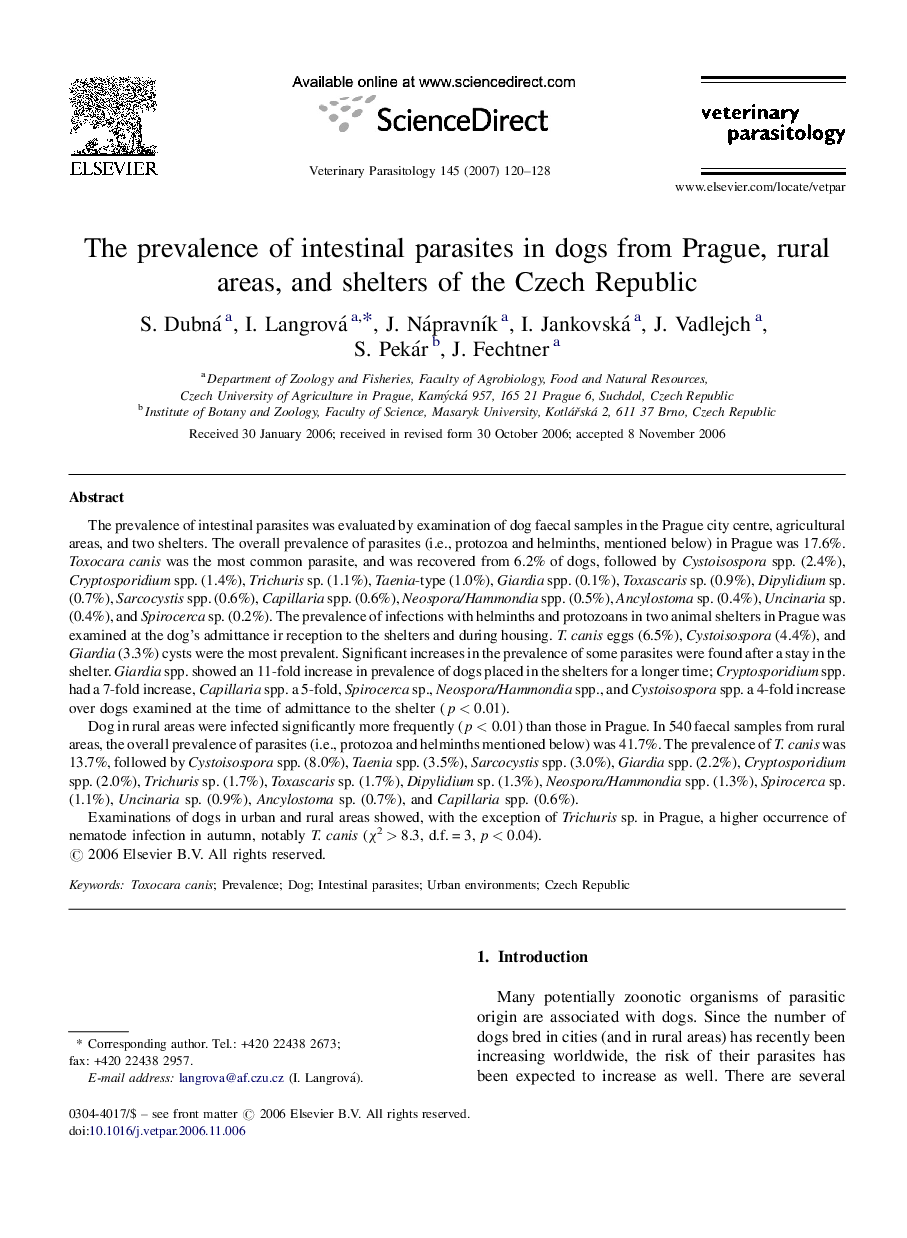| کد مقاله | کد نشریه | سال انتشار | مقاله انگلیسی | نسخه تمام متن |
|---|---|---|---|---|
| 2472065 | 1555784 | 2007 | 9 صفحه PDF | دانلود رایگان |

The prevalence of intestinal parasites was evaluated by examination of dog faecal samples in the Prague city centre, agricultural areas, and two shelters. The overall prevalence of parasites (i.e., protozoa and helminths, mentioned below) in Prague was 17.6%. Toxocara canis was the most common parasite, and was recovered from 6.2% of dogs, followed by Cystoisospora spp. (2.4%), Cryptosporidium spp. (1.4%), Trichuris sp. (1.1%), Taenia-type (1.0%), Giardia spp. (0.1%), Toxascaris sp. (0.9%), Dipylidium sp. (0.7%), Sarcocystis spp. (0.6%), Capillaria spp. (0.6%), Neospora/Hammondia spp. (0.5%), Ancylostoma sp. (0.4%), Uncinaria sp. (0.4%), and Spirocerca sp. (0.2%). The prevalence of infections with helminths and protozoans in two animal shelters in Prague was examined at the dog's admittance ir reception to the shelters and during housing. T. canis eggs (6.5%), Cystoisospora (4.4%), and Giardia (3.3%) cysts were the most prevalent. Significant increases in the prevalence of some parasites were found after a stay in the shelter. Giardia spp. showed an 11-fold increase in prevalence of dogs placed in the shelters for a longer time; Cryptosporidium spp. had a 7-fold increase, Capillaria spp. a 5-fold, Spirocerca sp., Neospora/Hammondia spp., and Cystoisospora spp. a 4-fold increase over dogs examined at the time of admittance to the shelter (p < 0.01).Dog in rural areas were infected significantly more frequently (p < 0.01) than those in Prague. In 540 faecal samples from rural areas, the overall prevalence of parasites (i.e., protozoa and helminths mentioned below) was 41.7%. The prevalence of T. canis was 13.7%, followed by Cystoisospora spp. (8.0%), Taenia spp. (3.5%), Sarcocystis spp. (3.0%), Giardia spp. (2.2%), Cryptosporidium spp. (2.0%), Trichuris sp. (1.7%), Toxascaris sp. (1.7%), Dipylidium sp. (1.3%), Neospora/Hammondia spp. (1.3%), Spirocerca sp. (1.1%), Uncinaria sp. (0.9%), Ancylostoma sp. (0.7%), and Capillaria spp. (0.6%).Examinations of dogs in urban and rural areas showed, with the exception of Trichuris sp. in Prague, a higher occurrence of nematode infection in autumn, notably T. canis (χ2 > 8.3, d.f. = 3, p < 0.04).
Journal: Veterinary Parasitology - Volume 145, Issues 1–2, 10 April 2007, Pages 120–128